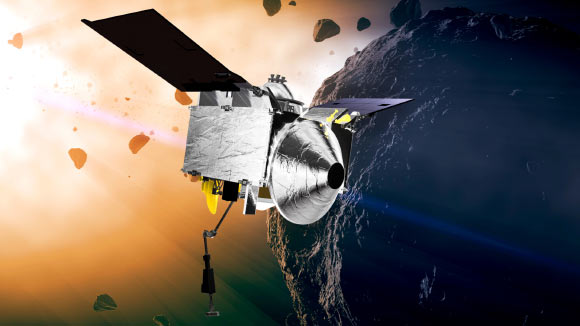Stunning new images, taken by the SamCam imager onboard NASA’s OSIRIS-REx spacecraft on October 20, 2020, show the historic Touch-And-Go (TAG) sample collection from the surface of near-Earth asteroid Bennu.
The newly-released sequence was created using 82 images from OSIRIS-REx’s SamCam instrument, with 1.25 seconds between frames.
It begins at about 25 m (82 feet) above the surface of Bennu, and runs through the back-away maneuver, with the last image in the sequence taken at 13 m (43 feet) in altitude — about 35 seconds after backing away.
The sampling event brought OSIRIS-REx all the way down to the Nightingale site, touching down within 1 m (3.3 feet) of the targeted location.
Preliminary data show the 0.3-m- (1-foot-) wide sampling head touched Bennu’s surface for approximately 6 seconds, after which the spacecraft performed a back-away burn.
OSIRIS-REx’s sampling arm — called the Touch-And-Go Sample Acquisition Mechanism (TAGSAM) — is visible in the lower part of the frame.
The round head at the end of TAGSAM is the only part of the spacecraft that contacted the surface during the sample collection event.
In the middle of the image sequence, the sampling head positions itself to contact the asteroid’s surface head-on.
Shortly after, the sampling head impacts the Nightingale site and penetrates Bennu’s regolith.
Upon initial contact, the TAGSAM head appears to crush some of the porous rocks underneath it.
One second later, OSIRIS-REx fires a nitrogen gas bottle, which mobilizes a substantial amount of the sample site’s material.
Preliminary data show the spacecraft spent 5 of the 6 seconds of contact collecting surface material, and the majority of sample collection occurred within the first 3 seconds.
TAGSAM is designed to catch the agitated surface material, and the mission team will assess the amount of material collected through various spacecraft activities. The team’s goal is at least 60 grams of regolith.
After touchdown, OSIRIS-REx fired its thrusters to back away from Bennu.
As expected, this maneuver also disturbed the Nightingale site, and loose debris is visible near the end of the image sequence.
The spacecraft was traveling at 10 cm/sec (0.2 mph) when it contacted the Nightingale site and then backed away at 40 cm/sec (0.9 mph).
_____
This article is based on a press-release provided by the National Aeronautics and Space Administration.








